Accounting and Finance Report: Capital Budgeting and WACC Analysis
VerifiedAdded on 2022/08/31
|10
|1379
|21
Report
AI Summary
This report provides a comprehensive analysis of accounting and finance principles, focusing on capital budgeting techniques and the Weighted Average Cost of Capital (WACC). The report analyzes a project for Sun Solar Ltd, evaluating its financial viability using metrics such as Net Present Value (NPV), Payback Period, and Profitability Index. It delves into sensitivity analysis and the selection of mutually exclusive projects, using methods like the equivalent annuity approach and replacement chain method. Furthermore, the report determines the value and cost of debt, preference shares, and ordinary equity shares, essential components for calculating WACC. The WACC is calculated and its impact on company earnings is assessed, providing insights into financial decision-making. The report utilizes data and projections provided in the assignment brief to perform its analysis.
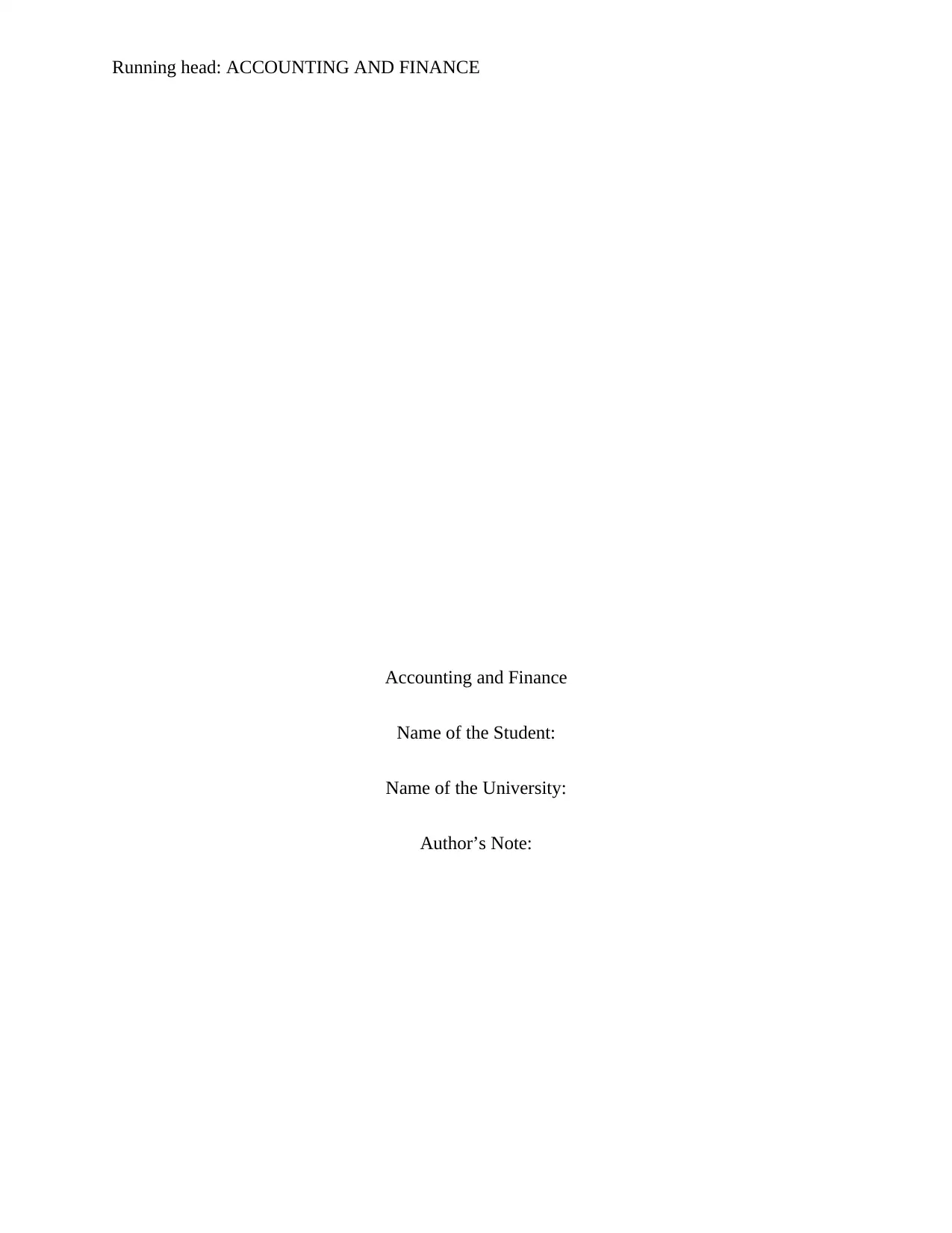
Running head: ACCOUNTING AND FINANCE
Accounting and Finance
Name of the Student:
Name of the University:
Author’s Note:
Accounting and Finance
Name of the Student:
Name of the University:
Author’s Note:
Paraphrase This Document
Need a fresh take? Get an instant paraphrase of this document with our AI Paraphraser
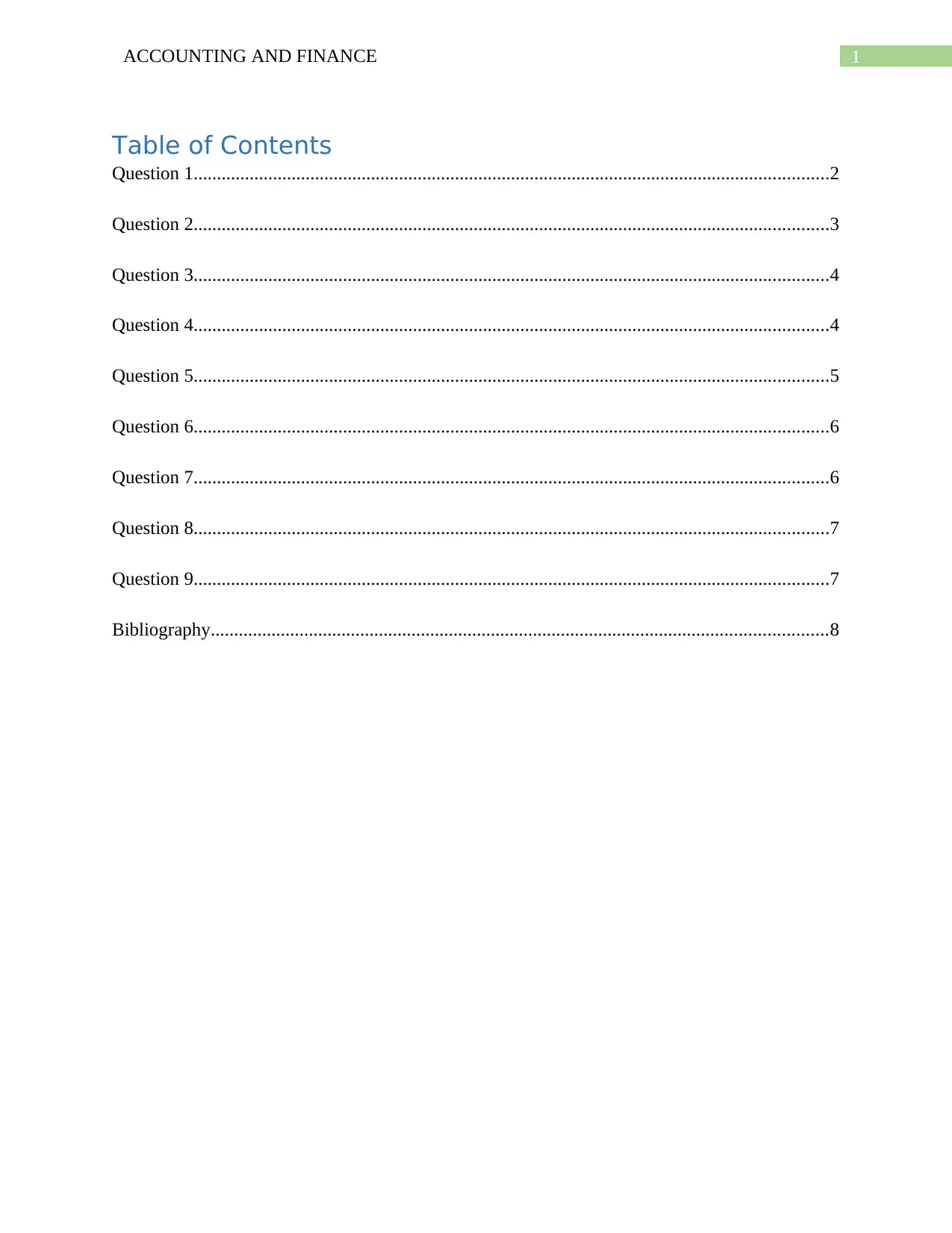
1ACCOUNTING AND FINANCE
Table of Contents
Question 1........................................................................................................................................2
Question 2........................................................................................................................................3
Question 3........................................................................................................................................4
Question 4........................................................................................................................................4
Question 5........................................................................................................................................5
Question 6........................................................................................................................................6
Question 7........................................................................................................................................6
Question 8........................................................................................................................................7
Question 9........................................................................................................................................7
Bibliography....................................................................................................................................8
Table of Contents
Question 1........................................................................................................................................2
Question 2........................................................................................................................................3
Question 3........................................................................................................................................4
Question 4........................................................................................................................................4
Question 5........................................................................................................................................5
Question 6........................................................................................................................................6
Question 7........................................................................................................................................6
Question 8........................................................................................................................................7
Question 9........................................................................................................................................7
Bibliography....................................................................................................................................8
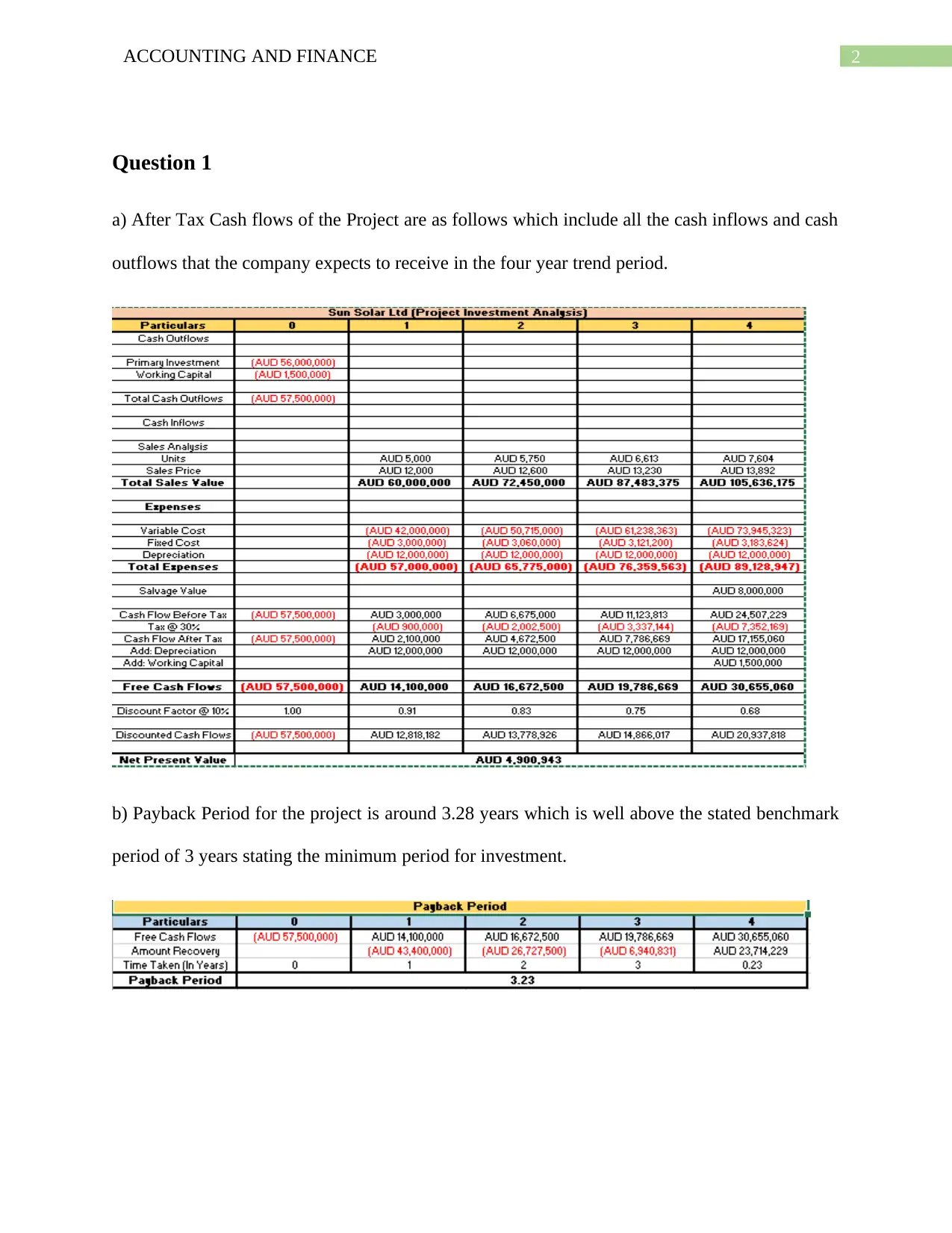
2ACCOUNTING AND FINANCE
Question 1
a) After Tax Cash flows of the Project are as follows which include all the cash inflows and cash
outflows that the company expects to receive in the four year trend period.
b) Payback Period for the project is around 3.28 years which is well above the stated benchmark
period of 3 years stating the minimum period for investment.
Question 1
a) After Tax Cash flows of the Project are as follows which include all the cash inflows and cash
outflows that the company expects to receive in the four year trend period.
b) Payback Period for the project is around 3.28 years which is well above the stated benchmark
period of 3 years stating the minimum period for investment.
⊘ This is a preview!⊘
Do you want full access?
Subscribe today to unlock all pages.

Trusted by 1+ million students worldwide
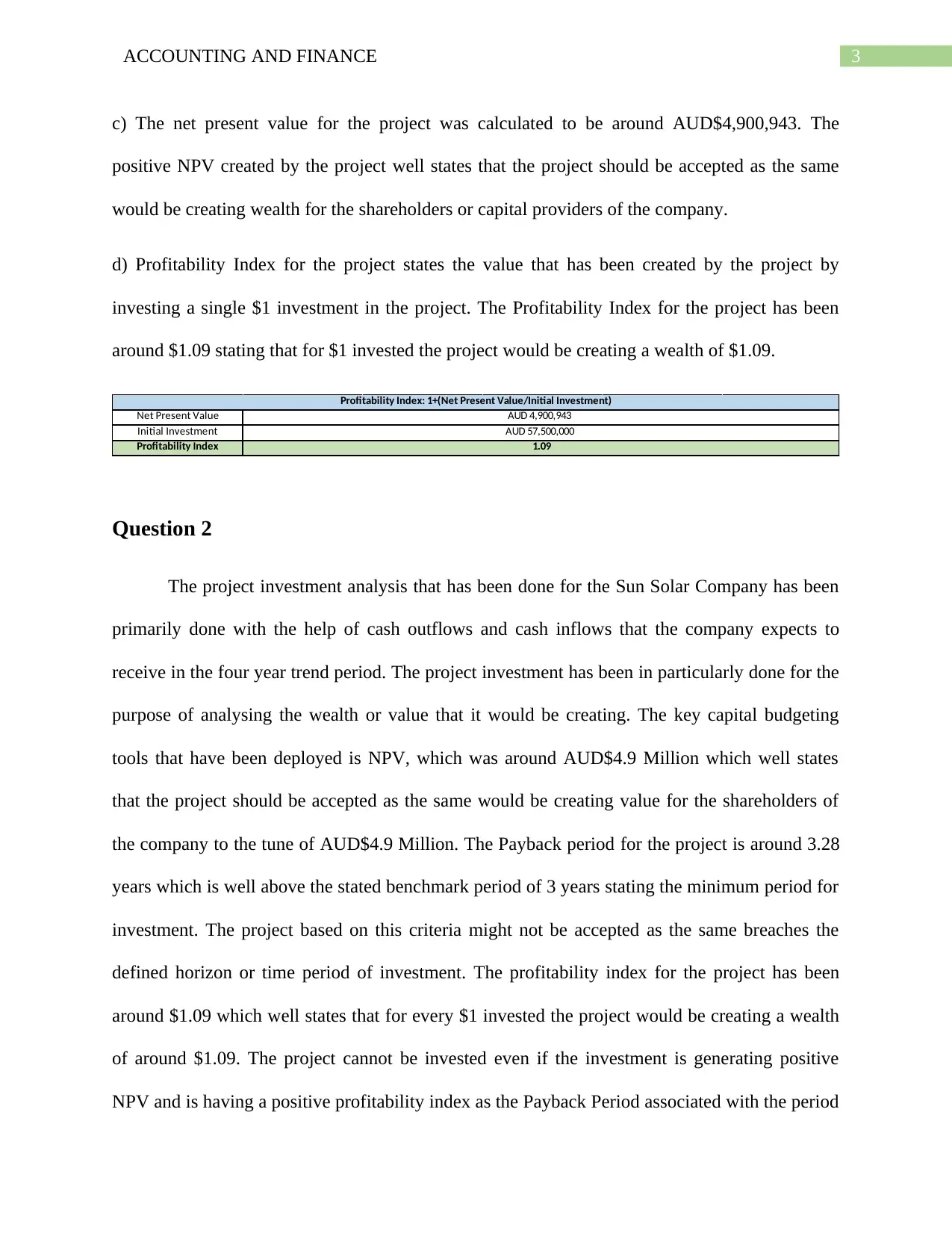
3ACCOUNTING AND FINANCE
c) The net present value for the project was calculated to be around AUD$4,900,943. The
positive NPV created by the project well states that the project should be accepted as the same
would be creating wealth for the shareholders or capital providers of the company.
d) Profitability Index for the project states the value that has been created by the project by
investing a single $1 investment in the project. The Profitability Index for the project has been
around $1.09 stating that for $1 invested the project would be creating a wealth of $1.09.
Net Present Value
Initial Investment
Profitability Index
Profitability Index: 1+(Net Present Value/Initial Investment)
1.09
AUD 57,500,000
AUD 4,900,943
Question 2
The project investment analysis that has been done for the Sun Solar Company has been
primarily done with the help of cash outflows and cash inflows that the company expects to
receive in the four year trend period. The project investment has been in particularly done for the
purpose of analysing the wealth or value that it would be creating. The key capital budgeting
tools that have been deployed is NPV, which was around AUD$4.9 Million which well states
that the project should be accepted as the same would be creating value for the shareholders of
the company to the tune of AUD$4.9 Million. The Payback period for the project is around 3.28
years which is well above the stated benchmark period of 3 years stating the minimum period for
investment. The project based on this criteria might not be accepted as the same breaches the
defined horizon or time period of investment. The profitability index for the project has been
around $1.09 which well states that for every $1 invested the project would be creating a wealth
of around $1.09. The project cannot be invested even if the investment is generating positive
NPV and is having a positive profitability index as the Payback Period associated with the period
c) The net present value for the project was calculated to be around AUD$4,900,943. The
positive NPV created by the project well states that the project should be accepted as the same
would be creating wealth for the shareholders or capital providers of the company.
d) Profitability Index for the project states the value that has been created by the project by
investing a single $1 investment in the project. The Profitability Index for the project has been
around $1.09 stating that for $1 invested the project would be creating a wealth of $1.09.
Net Present Value
Initial Investment
Profitability Index
Profitability Index: 1+(Net Present Value/Initial Investment)
1.09
AUD 57,500,000
AUD 4,900,943
Question 2
The project investment analysis that has been done for the Sun Solar Company has been
primarily done with the help of cash outflows and cash inflows that the company expects to
receive in the four year trend period. The project investment has been in particularly done for the
purpose of analysing the wealth or value that it would be creating. The key capital budgeting
tools that have been deployed is NPV, which was around AUD$4.9 Million which well states
that the project should be accepted as the same would be creating value for the shareholders of
the company to the tune of AUD$4.9 Million. The Payback period for the project is around 3.28
years which is well above the stated benchmark period of 3 years stating the minimum period for
investment. The project based on this criteria might not be accepted as the same breaches the
defined horizon or time period of investment. The profitability index for the project has been
around $1.09 which well states that for every $1 invested the project would be creating a wealth
of around $1.09. The project cannot be invested even if the investment is generating positive
NPV and is having a positive profitability index as the Payback Period associated with the period
Paraphrase This Document
Need a fresh take? Get an instant paraphrase of this document with our AI Paraphraser
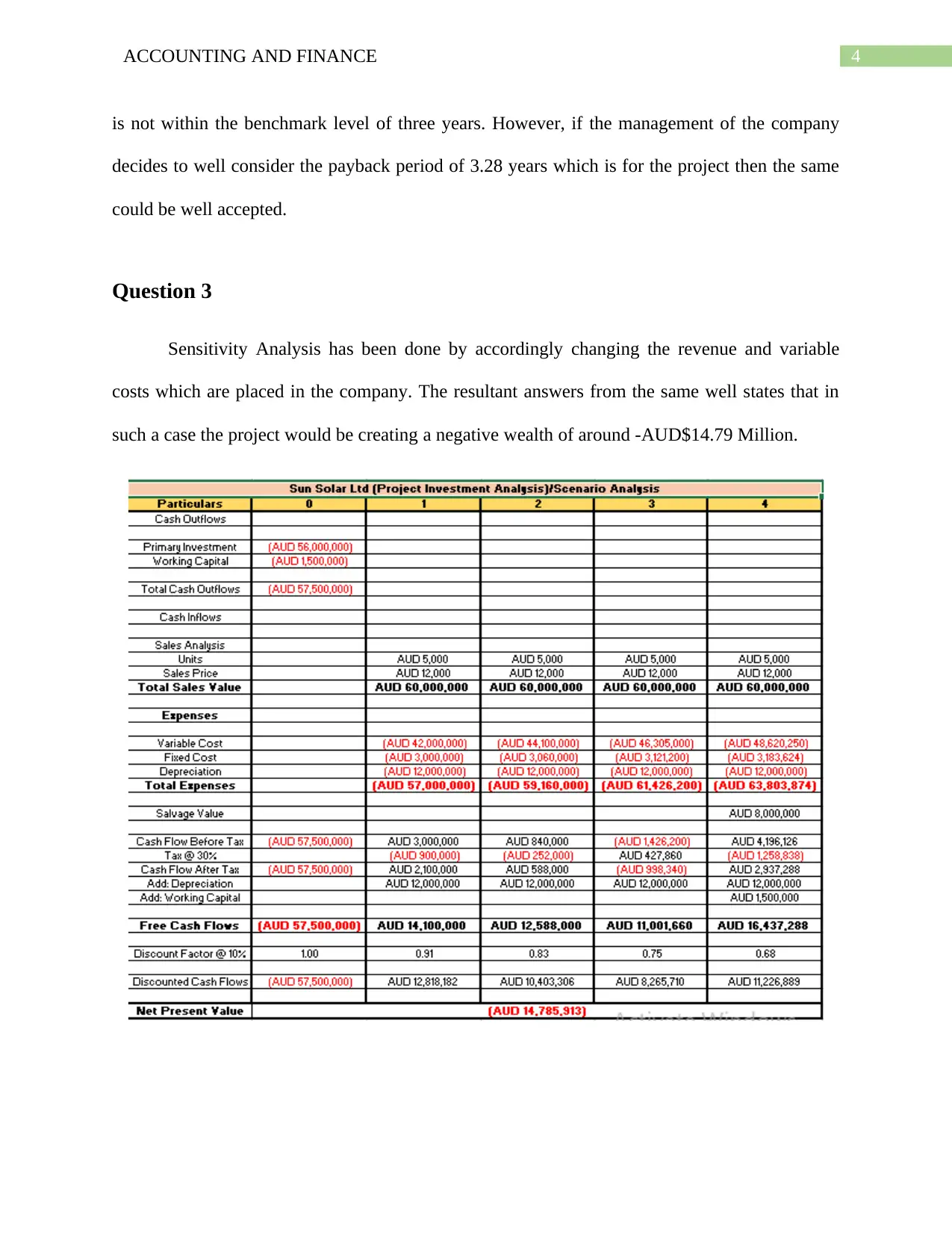
4ACCOUNTING AND FINANCE
is not within the benchmark level of three years. However, if the management of the company
decides to well consider the payback period of 3.28 years which is for the project then the same
could be well accepted.
Question 3
Sensitivity Analysis has been done by accordingly changing the revenue and variable
costs which are placed in the company. The resultant answers from the same well states that in
such a case the project would be creating a negative wealth of around -AUD$14.79 Million.
is not within the benchmark level of three years. However, if the management of the company
decides to well consider the payback period of 3.28 years which is for the project then the same
could be well accepted.
Question 3
Sensitivity Analysis has been done by accordingly changing the revenue and variable
costs which are placed in the company. The resultant answers from the same well states that in
such a case the project would be creating a negative wealth of around -AUD$14.79 Million.
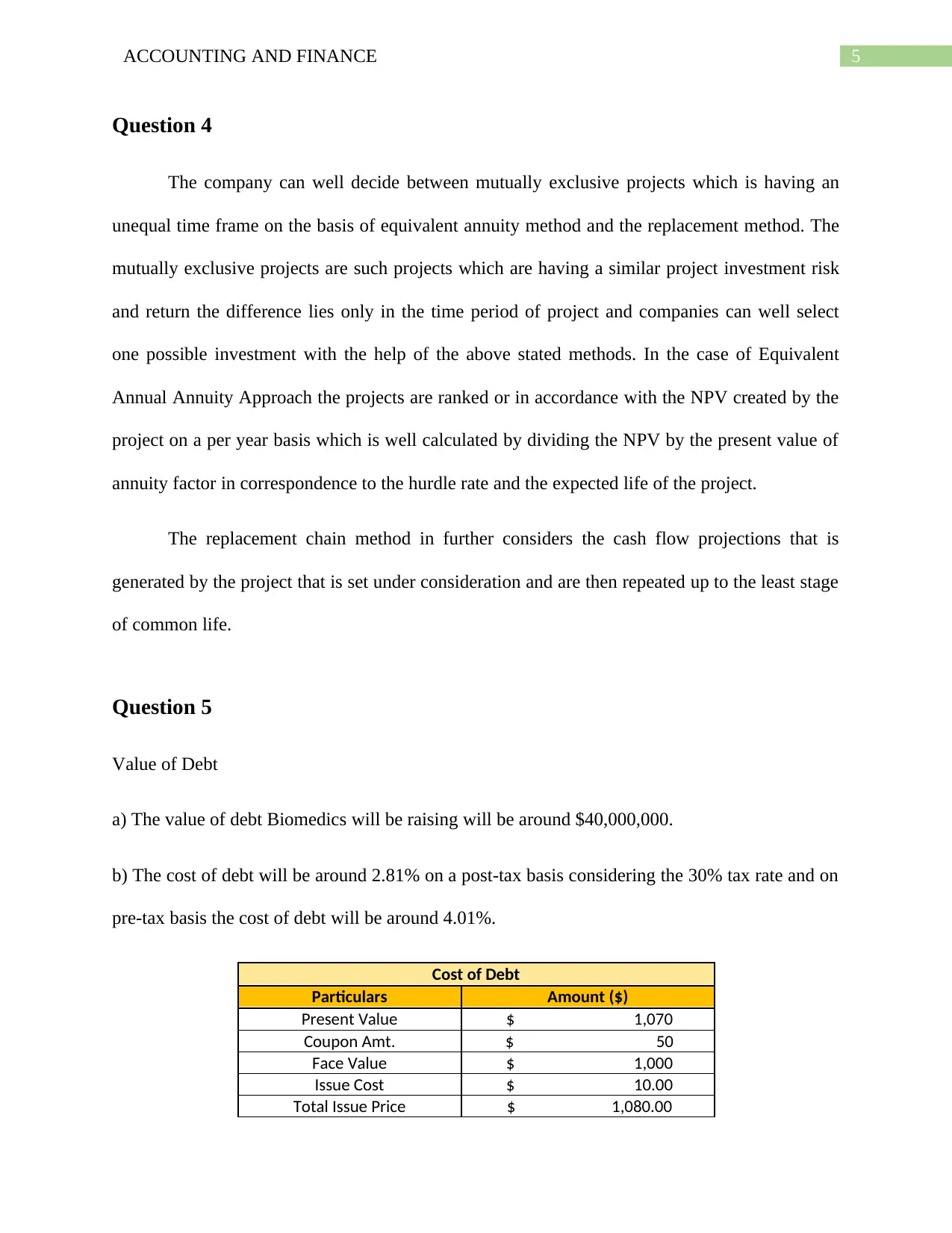
5ACCOUNTING AND FINANCE
Question 4
The company can well decide between mutually exclusive projects which is having an
unequal time frame on the basis of equivalent annuity method and the replacement method. The
mutually exclusive projects are such projects which are having a similar project investment risk
and return the difference lies only in the time period of project and companies can well select
one possible investment with the help of the above stated methods. In the case of Equivalent
Annual Annuity Approach the projects are ranked or in accordance with the NPV created by the
project on a per year basis which is well calculated by dividing the NPV by the present value of
annuity factor in correspondence to the hurdle rate and the expected life of the project.
The replacement chain method in further considers the cash flow projections that is
generated by the project that is set under consideration and are then repeated up to the least stage
of common life.
Question 5
Value of Debt
a) The value of debt Biomedics will be raising will be around $40,000,000.
b) The cost of debt will be around 2.81% on a post-tax basis considering the 30% tax rate and on
pre-tax basis the cost of debt will be around 4.01%.
Cost of Debt
Particulars Amount ($)
Present Value $ 1,070
Coupon Amt. $ 50
Face Value $ 1,000
Issue Cost $ 10.00
Total Issue Price $ 1,080.00
Question 4
The company can well decide between mutually exclusive projects which is having an
unequal time frame on the basis of equivalent annuity method and the replacement method. The
mutually exclusive projects are such projects which are having a similar project investment risk
and return the difference lies only in the time period of project and companies can well select
one possible investment with the help of the above stated methods. In the case of Equivalent
Annual Annuity Approach the projects are ranked or in accordance with the NPV created by the
project on a per year basis which is well calculated by dividing the NPV by the present value of
annuity factor in correspondence to the hurdle rate and the expected life of the project.
The replacement chain method in further considers the cash flow projections that is
generated by the project that is set under consideration and are then repeated up to the least stage
of common life.
Question 5
Value of Debt
a) The value of debt Biomedics will be raising will be around $40,000,000.
b) The cost of debt will be around 2.81% on a post-tax basis considering the 30% tax rate and on
pre-tax basis the cost of debt will be around 4.01%.
Cost of Debt
Particulars Amount ($)
Present Value $ 1,070
Coupon Amt. $ 50
Face Value $ 1,000
Issue Cost $ 10.00
Total Issue Price $ 1,080.00
⊘ This is a preview!⊘
Do you want full access?
Subscribe today to unlock all pages.

Trusted by 1+ million students worldwide
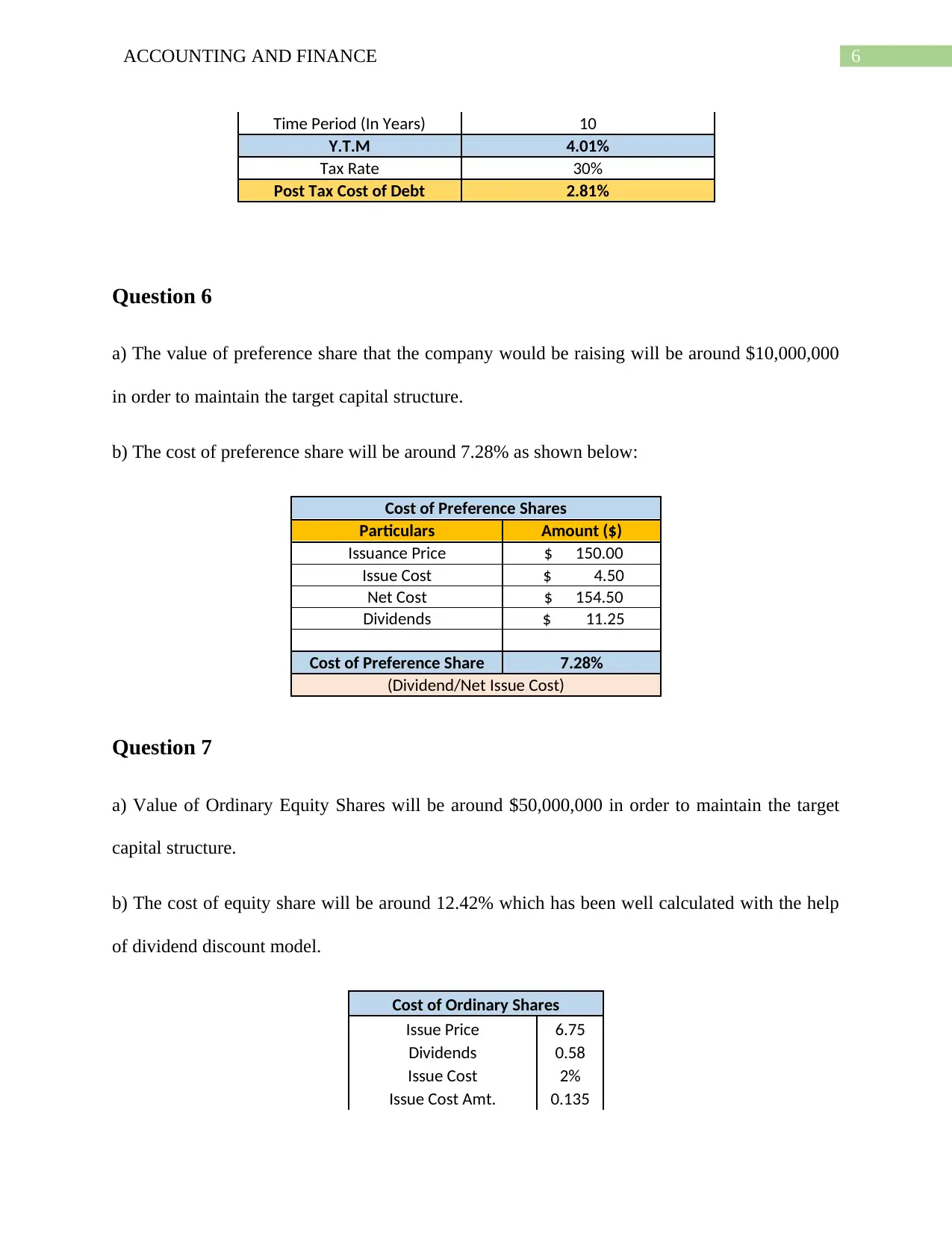
6ACCOUNTING AND FINANCE
Time Period (In Years) 10
Y.T.M 4.01%
Tax Rate 30%
Post Tax Cost of Debt 2.81%
Question 6
a) The value of preference share that the company would be raising will be around $10,000,000
in order to maintain the target capital structure.
b) The cost of preference share will be around 7.28% as shown below:
Cost of Preference Shares
Particulars Amount ($)
Issuance Price $ 150.00
Issue Cost $ 4.50
Net Cost $ 154.50
Dividends $ 11.25
Cost of Preference Share 7.28%
(Dividend/Net Issue Cost)
Question 7
a) Value of Ordinary Equity Shares will be around $50,000,000 in order to maintain the target
capital structure.
b) The cost of equity share will be around 12.42% which has been well calculated with the help
of dividend discount model.
Cost of Ordinary Shares
Issue Price 6.75
Dividends 0.58
Issue Cost 2%
Issue Cost Amt. 0.135
Time Period (In Years) 10
Y.T.M 4.01%
Tax Rate 30%
Post Tax Cost of Debt 2.81%
Question 6
a) The value of preference share that the company would be raising will be around $10,000,000
in order to maintain the target capital structure.
b) The cost of preference share will be around 7.28% as shown below:
Cost of Preference Shares
Particulars Amount ($)
Issuance Price $ 150.00
Issue Cost $ 4.50
Net Cost $ 154.50
Dividends $ 11.25
Cost of Preference Share 7.28%
(Dividend/Net Issue Cost)
Question 7
a) Value of Ordinary Equity Shares will be around $50,000,000 in order to maintain the target
capital structure.
b) The cost of equity share will be around 12.42% which has been well calculated with the help
of dividend discount model.
Cost of Ordinary Shares
Issue Price 6.75
Dividends 0.58
Issue Cost 2%
Issue Cost Amt. 0.135
Paraphrase This Document
Need a fresh take? Get an instant paraphrase of this document with our AI Paraphraser
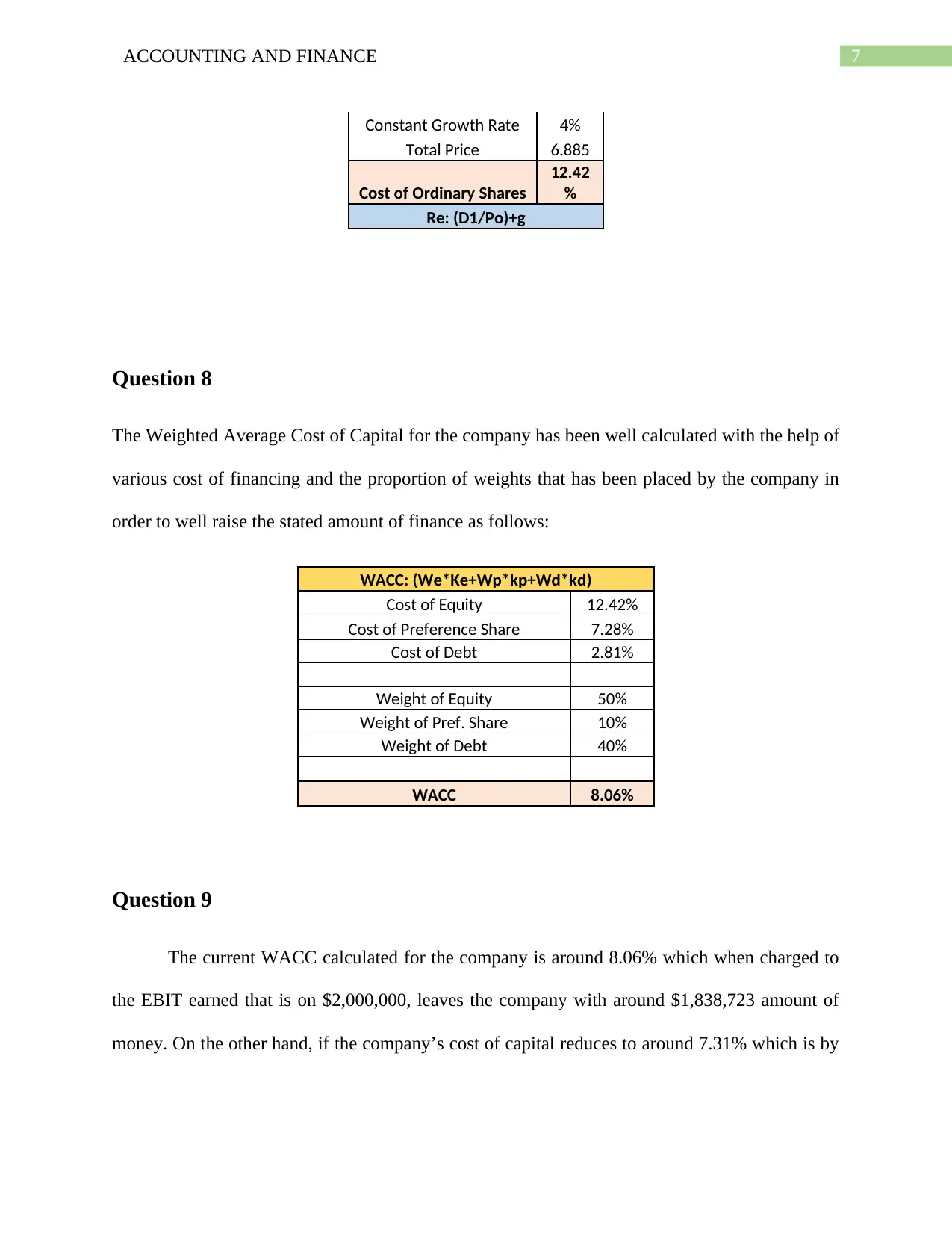
7ACCOUNTING AND FINANCE
Constant Growth Rate 4%
Total Price 6.885
Cost of Ordinary Shares
12.42
%
Re: (D1/Po)+g
Question 8
The Weighted Average Cost of Capital for the company has been well calculated with the help of
various cost of financing and the proportion of weights that has been placed by the company in
order to well raise the stated amount of finance as follows:
WACC: (We*Ke+Wp*kp+Wd*kd)
Cost of Equity 12.42%
Cost of Preference Share 7.28%
Cost of Debt 2.81%
Weight of Equity 50%
Weight of Pref. Share 10%
Weight of Debt 40%
WACC 8.06%
Question 9
The current WACC calculated for the company is around 8.06% which when charged to
the EBIT earned that is on $2,000,000, leaves the company with around $1,838,723 amount of
money. On the other hand, if the company’s cost of capital reduces to around 7.31% which is by
Constant Growth Rate 4%
Total Price 6.885
Cost of Ordinary Shares
12.42
%
Re: (D1/Po)+g
Question 8
The Weighted Average Cost of Capital for the company has been well calculated with the help of
various cost of financing and the proportion of weights that has been placed by the company in
order to well raise the stated amount of finance as follows:
WACC: (We*Ke+Wp*kp+Wd*kd)
Cost of Equity 12.42%
Cost of Preference Share 7.28%
Cost of Debt 2.81%
Weight of Equity 50%
Weight of Pref. Share 10%
Weight of Debt 40%
WACC 8.06%
Question 9
The current WACC calculated for the company is around 8.06% which when charged to
the EBIT earned that is on $2,000,000, leaves the company with around $1,838,723 amount of
money. On the other hand, if the company’s cost of capital reduces to around 7.31% which is by
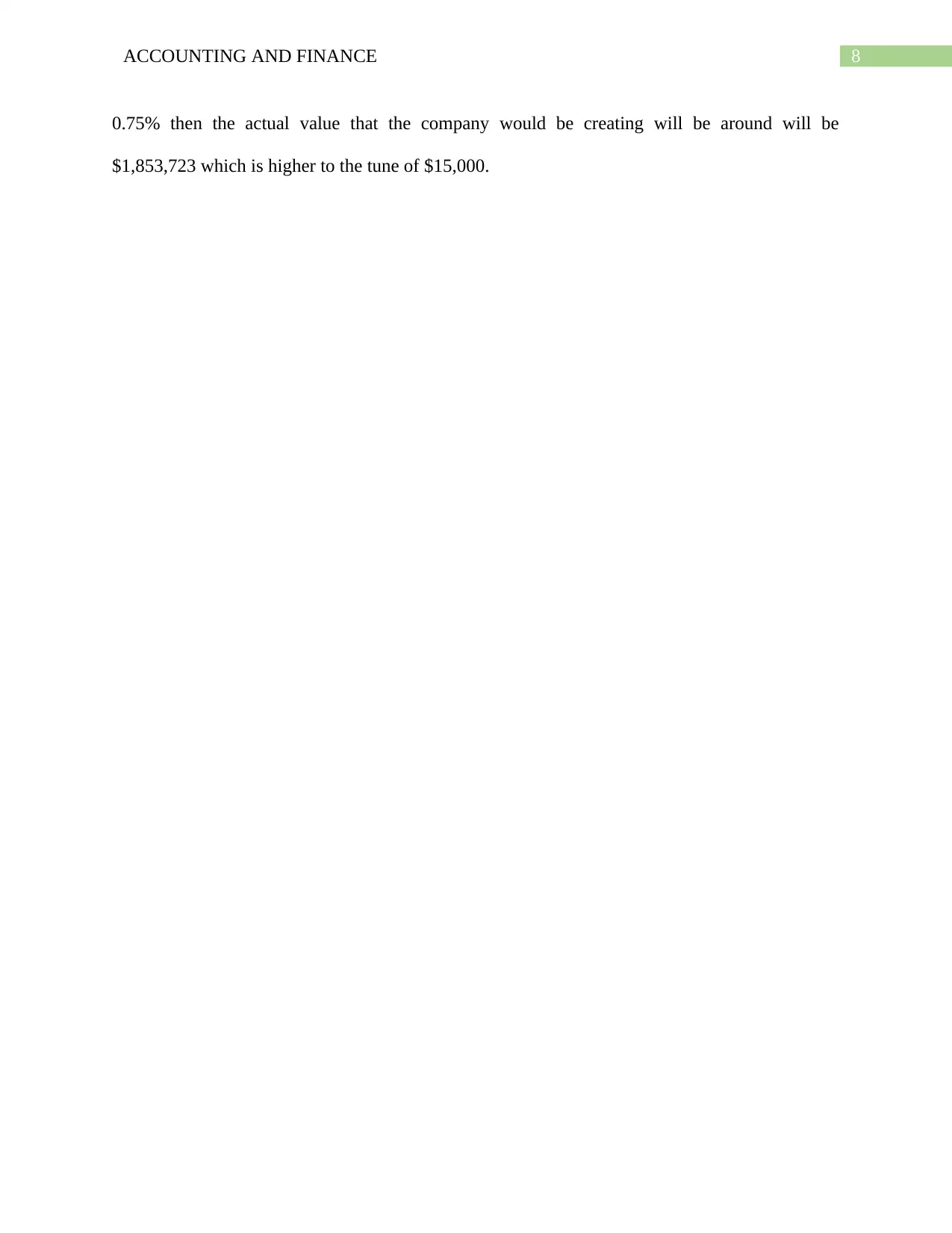
8ACCOUNTING AND FINANCE
0.75% then the actual value that the company would be creating will be around will be
$1,853,723 which is higher to the tune of $15,000.
0.75% then the actual value that the company would be creating will be around will be
$1,853,723 which is higher to the tune of $15,000.
⊘ This is a preview!⊘
Do you want full access?
Subscribe today to unlock all pages.

Trusted by 1+ million students worldwide
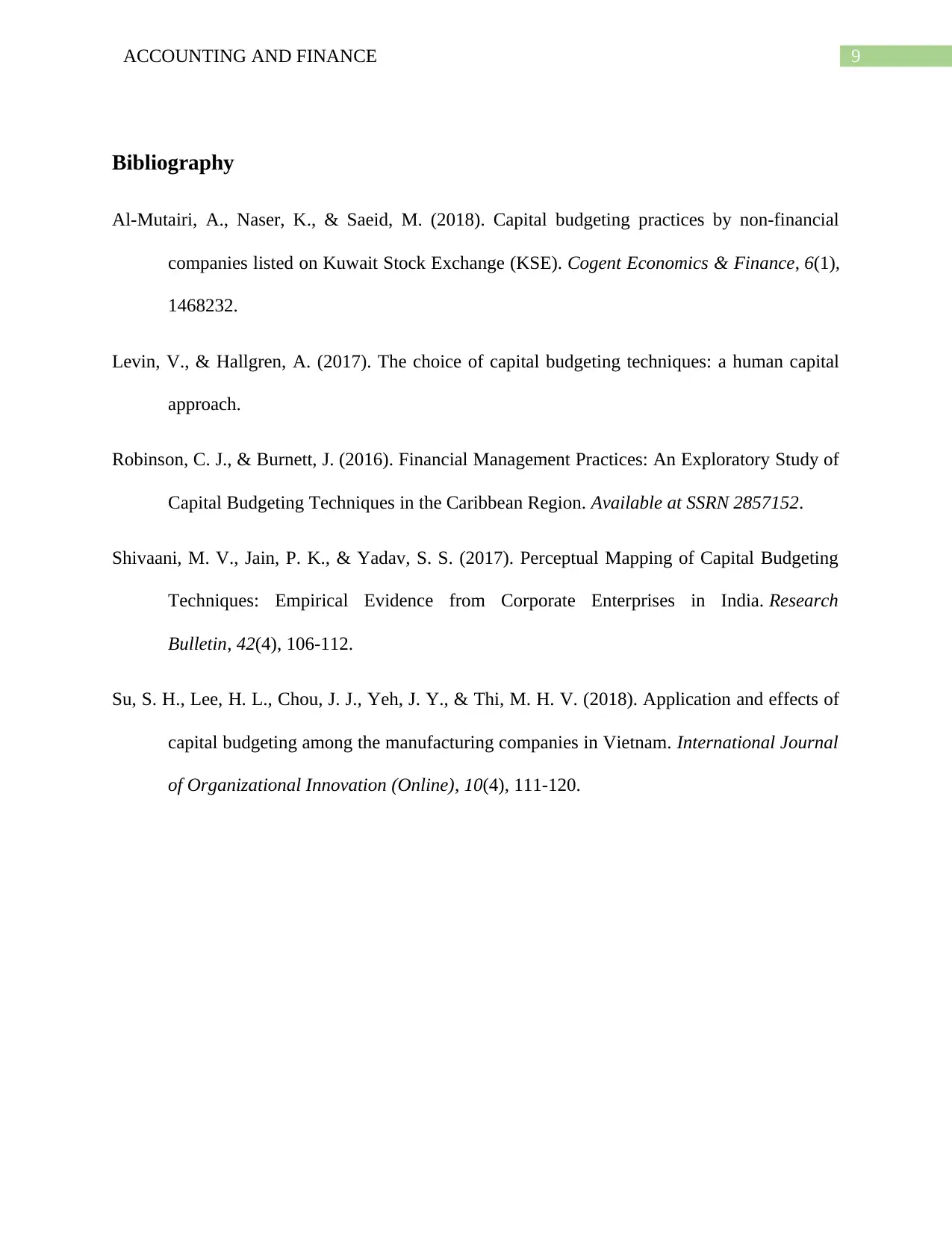
9ACCOUNTING AND FINANCE
Bibliography
Al-Mutairi, A., Naser, K., & Saeid, M. (2018). Capital budgeting practices by non-financial
companies listed on Kuwait Stock Exchange (KSE). Cogent Economics & Finance, 6(1),
1468232.
Levin, V., & Hallgren, A. (2017). The choice of capital budgeting techniques: a human capital
approach.
Robinson, C. J., & Burnett, J. (2016). Financial Management Practices: An Exploratory Study of
Capital Budgeting Techniques in the Caribbean Region. Available at SSRN 2857152.
Shivaani, M. V., Jain, P. K., & Yadav, S. S. (2017). Perceptual Mapping of Capital Budgeting
Techniques: Empirical Evidence from Corporate Enterprises in India. Research
Bulletin, 42(4), 106-112.
Su, S. H., Lee, H. L., Chou, J. J., Yeh, J. Y., & Thi, M. H. V. (2018). Application and effects of
capital budgeting among the manufacturing companies in Vietnam. International Journal
of Organizational Innovation (Online), 10(4), 111-120.
Bibliography
Al-Mutairi, A., Naser, K., & Saeid, M. (2018). Capital budgeting practices by non-financial
companies listed on Kuwait Stock Exchange (KSE). Cogent Economics & Finance, 6(1),
1468232.
Levin, V., & Hallgren, A. (2017). The choice of capital budgeting techniques: a human capital
approach.
Robinson, C. J., & Burnett, J. (2016). Financial Management Practices: An Exploratory Study of
Capital Budgeting Techniques in the Caribbean Region. Available at SSRN 2857152.
Shivaani, M. V., Jain, P. K., & Yadav, S. S. (2017). Perceptual Mapping of Capital Budgeting
Techniques: Empirical Evidence from Corporate Enterprises in India. Research
Bulletin, 42(4), 106-112.
Su, S. H., Lee, H. L., Chou, J. J., Yeh, J. Y., & Thi, M. H. V. (2018). Application and effects of
capital budgeting among the manufacturing companies in Vietnam. International Journal
of Organizational Innovation (Online), 10(4), 111-120.
1 out of 10
Related Documents
Your All-in-One AI-Powered Toolkit for Academic Success.
+13062052269
info@desklib.com
Available 24*7 on WhatsApp / Email
![[object Object]](/_next/static/media/star-bottom.7253800d.svg)
Unlock your academic potential
Copyright © 2020–2025 A2Z Services. All Rights Reserved. Developed and managed by ZUCOL.





